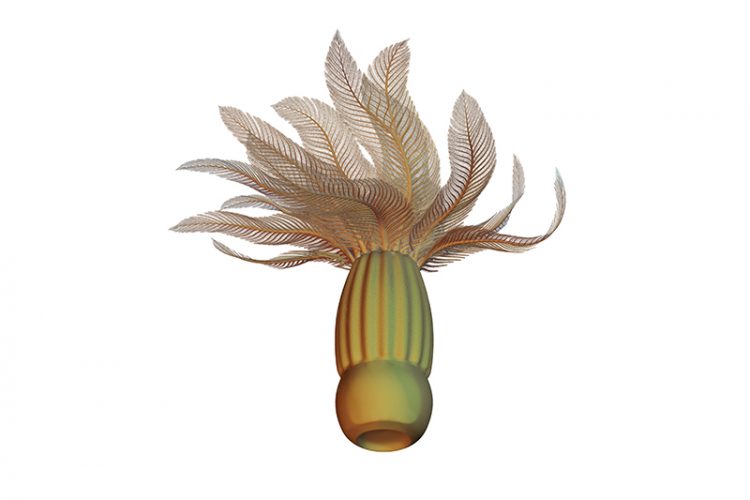Visiting researcher at Kassel University solves riddle of Cambrian fossils

Reconstruction of the feather polyp †Xianguangia sinica, an extinct representative of the cnidarian stem group. Copyright: Huanzhen Li & Qiang Ou
Based on the findings of Ou, Mayer, and additional co-authors of the study, the primeval creature †Xianguangia sinica, which lived approximately 520 million years ago, was an ancestral cnidarian, contrary to what was previously believed. The cnidarians today include jellyfish, corals, and sea anemones.
The animal measured approximately five centimetres in height and resembled a polyp, but possessed an additional body cavity that apparently served as a hydrostatic skeleton within an anchoring device at the base of the body. Feather-like tentacles with numerous cilia were characteristic for the species and served for capturing food particles from the water column.
“The ‘feather polyp’,” as the scientists informally named †X. sinica, “was a so-called suspension feeder,” says Mayer. This means that it filtered organic particles from the surrounding water through the action of cilia that transported food material towards the mouth. This finding refutes previous hypothesis that †X. sinica was a predator which, like most living cnidarians, caught macroscopic planktonic organisms using simple, unbranched tentacles laden with venomous cnidocytes.
The scientists have now been able to clarify the contradictory classification of the fossils †Chengjiangopenna wangii (a purported Cambrian “sea pen”) and †Galeaplumosus abilus (the “oldest hemichordate”). It now has become evident that these fossils are simply body fragments of †X. sinica. Previously, they had been incorrectly identified and described as separate species.
The detailed reconstruction of the body structure of †X. sinica was made possible by examining 85 new and exceptionally preserved specimens from the Chengjiang deposit in China. Ou, Mayer, and their colleagues examined these specimens using scanning electron microscopy (SEM) as well as energy-dispersive X-ray spectroscopy (EDX). In addition, the researchers conducted phylogenetic analyses in order to clarify the position of the fossil species in the animal tree of life. The results indicate that the diversity of cnidarian morphology and feeding behaviour was higher in the Cambrian than previously thought.
Major parts of this study were carried out at the University of Kassel where Dr. Qiang Ou (40) is conducting research as an Alexander von Humboldt Fellow in the Zoology department.
In the last decades, numerous previously unknown fossils have been discovered in the Chengjiang deposits, opening up new dimensions in our understanding of biodiversity in the Cambrian period. Many of these fossils, however, have not yet been completely and unequivocally analysed. The term “Cambrian explosion” refers to a massive emergence of new species during the Cambrian period approximately 530 million years ago.
The new results concerning the species †Xianguangia sinica have been published in the prestigious journal “Proceedings of the National Academy of Sciences of the United States of America”: http://www.pnas.org/content/early/2017/07/26/1701650114.abstract
Contact details:
Prof. Dr. Georg Mayer
University of Kassel
Department of Zoology
Phone: +49 (0)561 804-4805
E-Mail: georg.mayer@uni-kassel.de
http://www.uni-kassel.de/uni/universitaet/pressekommunikation/neues-vom-campus/m…
http://www.pnas.org/content/early/2017/07/26/1701650114.abstract
Media Contact
All latest news from the category: Earth Sciences
Earth Sciences (also referred to as Geosciences), which deals with basic issues surrounding our planet, plays a vital role in the area of energy and raw materials supply.
Earth Sciences comprises subjects such as geology, geography, geological informatics, paleontology, mineralogy, petrography, crystallography, geophysics, geodesy, glaciology, cartography, photogrammetry, meteorology and seismology, early-warning systems, earthquake research and polar research.
Newest articles

Compact LCOS Microdisplay with Fast CMOS Backplane
…for High-Speed Light Modulation. Researchers from the Fraunhofer Institute for Photonic Microsystems IPMS, in collaboration with HOLOEYE Photonics AG, have developed a compact LCOS microdisplay with high refresh rates that…

New perspectives for material detection
CRC MARIE enters third funding period: A major success for terahertz research: Scientists at the University of Duisburg-Essen and the Ruhr University Bochum have been researching mobile material detection since…

CD Laboratory at TU Graz Researches New Semiconductor Materials
Using energy- and resource-saving methods, a research team at the Institute of Inorganic Chemistry at TU Graz aims to produce high-quality doped silicon layers for the electronics and solar industries….



